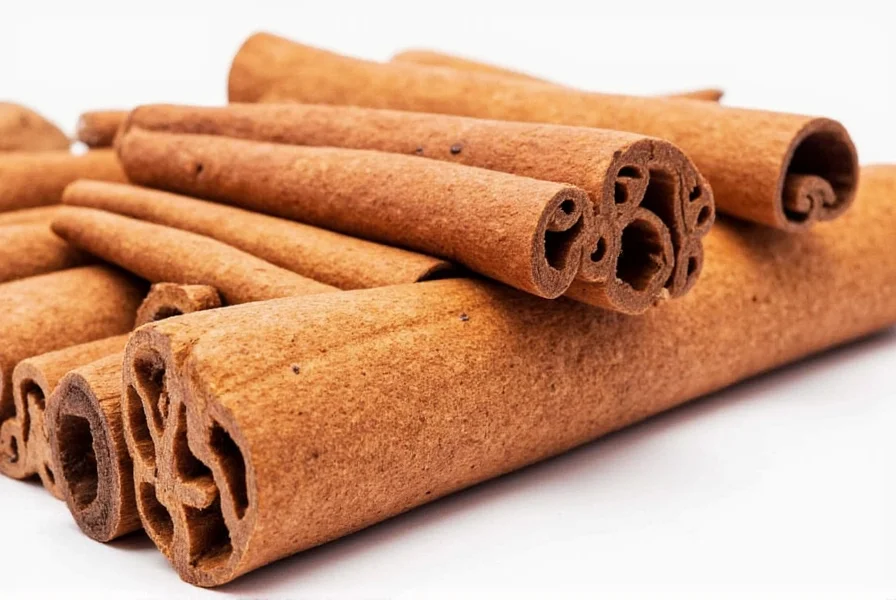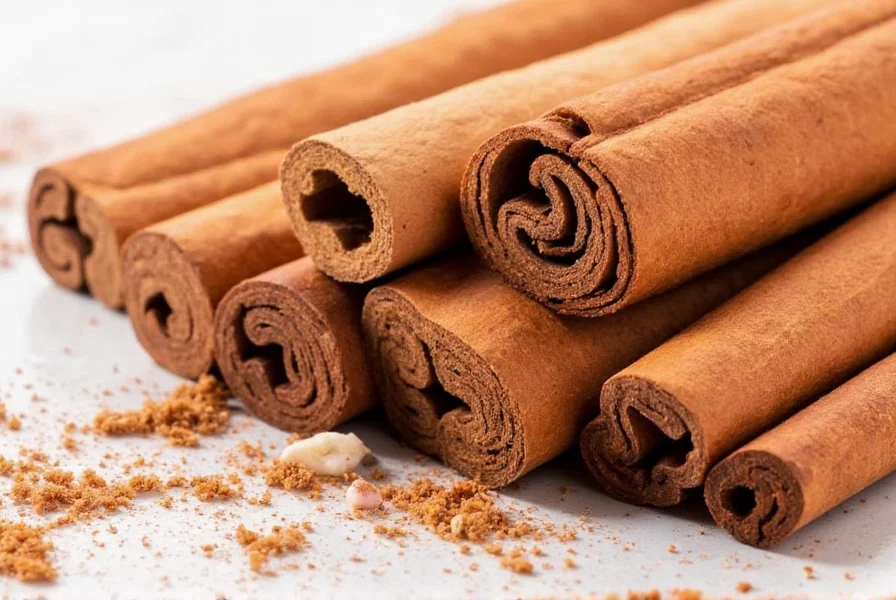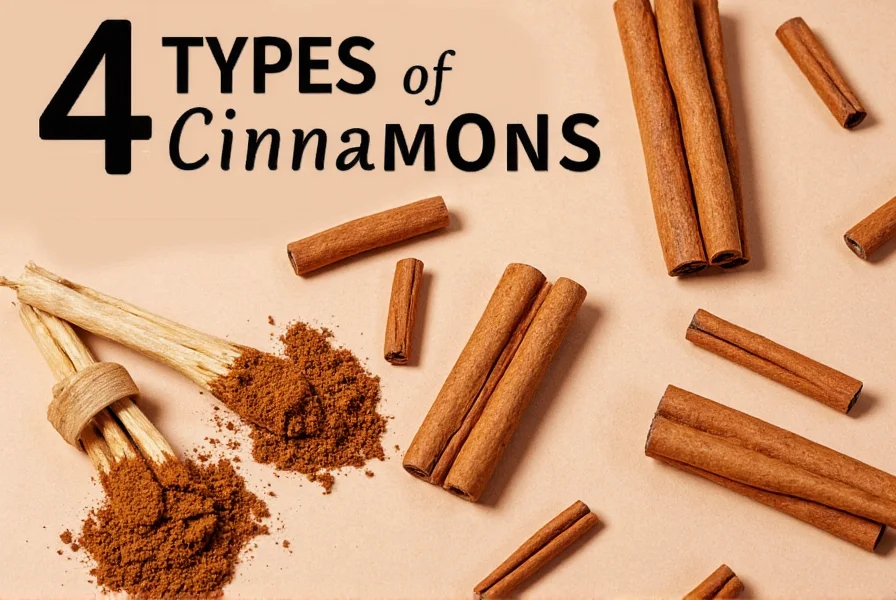There are four primary types of cinnamon available globally: Ceylon ("true" cinnamon), Chinese cassia, Saigon cinnamon, and Korintje cinnamon. Ceylon cinnamon, with its delicate flavor and lower coumarin content, is considered superior for regular consumption, while cassia varieties (Chinese, Saigon, and Korintje) offer stronger, spicier profiles but contain higher levels of coumarin which may pose health concerns with excessive consumption.
When you reach for that spice jar labeled "cinnamon," you're likely using one of several distinct varieties that differ significantly in flavor, appearance, and even health implications. Understanding the different types of cinnamon is essential for both culinary excellence and health-conscious consumption. While many consumers treat all cinnamon as interchangeable, the reality is that these varieties have unique characteristics that affect everything from baking results to long-term health impacts.
Ceylon Cinnamon: The True Cinnamon
Originating from Sri Lanka (formerly Ceylon), this variety represents only about 10-20% of the global cinnamon market but is considered "true" cinnamon by connoisseurs. Ceylon cinnamon comes from the Cinnamomum verum tree and features multiple delicate layers that form a tight, hollow tube. The sticks are light brown with a brittle texture that easily crumbles when bent.
Flavor-wise, Ceylon offers a subtle, sweet profile with citrusy notes and minimal heat. This makes it ideal for delicate desserts, custards, and beverages where you want cinnamon flavor without overwhelming other ingredients. Many professional bakers prefer Ceylon for French pastries and Scandinavian baking traditions where the nuanced flavor shines.
From a health perspective, Ceylon cinnamon contains significantly lower levels of coumarin—a natural compound that can cause liver damage in high doses—making it the safer choice for regular consumption, especially for children, pregnant women, or those with liver conditions.
Cassia Cinnamon Varieties
The majority of cinnamon sold in supermarkets across North America and Europe actually belongs to the cassia family, which includes three main varieties:
Chinese Cinnamon (Cinnamomum cassia)
This is the most common type found in grocery stores, often simply labeled as "cinnamon." Chinese cassia comes from southern China and features thick, hard sticks with a single rolled layer. The bark is dark reddish-brown with a rough texture that doesn't easily break.
Its flavor profile is robust, spicy, and somewhat bitter with a pronounced heat that stands up well in hearty dishes. This makes Chinese cassia ideal for spice cakes, gingerbread, and savory applications like Chinese five-spice powder or Moroccan tagines. However, it contains about 100 times more coumarin than Ceylon cinnamon, so regular consumption in large quantities may pose health risks.
Saigon Cinnamon (Cinnamomum loureiroi)
Hailing from Vietnam, Saigon cinnamon is considered the most intense variety with the highest oil content (2-6% compared to 1-3% in Chinese cassia). The sticks are thick, dark, and extremely fragrant. Professional bakers often seek out Saigon cinnamon for its powerful flavor that holds up exceptionally well in commercial baking applications.
Its high coumarin content means it should be used sparingly, but its intense aroma makes it perfect for small-batch artisanal baking where maximum cinnamon impact is desired. Many cinnamon roll specialists prefer Saigon for its ability to maintain flavor through the baking process.
Korintje Cinnamon (Cinnamomum burmannii)
Originating from Indonesia, Korintje cinnamon (sometimes called Indonesian cassia) features thinner, more flexible sticks that are dark brown with visible bark layers. It has a moderately strong flavor—less intense than Saigon but stronger than Chinese cassia—with earthy notes.
Korintje represents a middle ground in both flavor intensity and coumarin content. It's commonly used in commercial food production because of its consistent quality and moderate price point. Many cinnamon-flavored cereals and processed foods use Korintje due to its reliable flavor profile at scale.
| Type | Origin | Appearance | Flavor Profile | Coumarin Content | Best Uses |
|---|---|---|---|---|---|
| Ceylon | Sri Lanka | Light brown, multiple thin layers, brittle | Delicate, sweet, citrus notes | Very low (0.004-0.1%) | Delicate desserts, beverages, regular consumption |
| Chinese Cassia | China | Dark reddish-brown, single thick layer | Strong, spicy, slightly bitter | High (1-5%) | Robust baking, savory dishes, occasional use |
| Saigon | Vietnam | Very dark, thick, extremely fragrant | Most intense, highest oil content | Very high (2-6%) | Artisanal baking, small-batch applications |
| Korintje | Indonesia | Dark brown, flexible sticks | Moderately strong, earthy | Moderate | Commercial food production, everyday cooking |
Health Considerations Across Cinnamon Types
One of the most significant differences between cinnamon varieties involves coumarin content. This naturally occurring compound gives cinnamon its distinctive aroma but can be problematic in large quantities. The European Food Safety Authority recommends a maximum daily intake of 0.1 mg of coumarin per kilogram of body weight.
Ceylon cinnamon contains only trace amounts of coumarin (approximately 0.004-0.1% by weight), making it safe for regular consumption even in relatively large quantities. In contrast, cassia varieties contain 1-5% coumarin, meaning just one teaspoon of cassia cinnamon could exceed the recommended daily limit for an average adult.
For individuals with liver conditions, those taking blood thinners, or anyone consuming cinnamon regularly for potential health benefits, choosing Ceylon over cassia varieties is strongly recommended by nutrition experts. Many "cinnamon supplements" on the market use cassia without disclosing the variety, potentially exposing consumers to unsafe coumarin levels.

How to Identify Different Cinnamon Types
Telling cinnamon varieties apart requires attention to several physical characteristics:
- Stick structure: Ceylon forms multiple thin layers like newspaper rolled tightly, while cassia varieties form a single thick layer
- Texture: Ceylon sticks are brittle and break easily when bent; cassia sticks are hard and resist bending
- Color: Ceylon is light tan to medium brown; cassia varieties range from reddish-brown to dark brown
- Smell: Ceylon has a delicate, sweet aroma; cassia varieties have a stronger, spicier scent
When purchasing ground cinnamon, identification becomes more challenging. Look for labels specifying "Ceylon" or "Cinnamomum verum" for true cinnamon. Some specialty spice companies provide origin information that can help determine the variety.
Culinary Applications and Substitution Guidelines
Understanding which cinnamon variety works best for specific applications can transform your cooking:
- For delicate desserts: Ceylon cinnamon shines in crème brûlée, rice pudding, and fruit compotes where its subtle flavor won't overpower
- For robust baking: Chinese cassia works well in gingerbread, snickerdoodles, and spice cakes where its strong flavor holds up
- For maximum impact: Saigon cinnamon delivers intense flavor in cinnamon rolls and coffee cakes
- For everyday cooking: Korintje offers a balanced option for general use in moderate quantities
When substituting between varieties, remember that Ceylon's milder flavor means you may need to use 25-50% more to achieve similar intensity to cassia varieties. Conversely, when replacing cassia with Ceylon in a recipe, you might reduce the amount slightly to avoid overwhelming other flavors.

Where to Find and Price Considerations
Ceylon cinnamon typically costs 2-4 times more than cassia varieties due to more labor-intensive harvesting methods and lower global production. You'll find it in specialty spice shops, higher-end grocery stores, and online retailers that specialize in premium spices.
When shopping for cinnamon, look for recent harvest dates as cinnamon loses potency over time. Properly stored in an airtight container away from light, whole cinnamon sticks maintain quality for 1-2 years, while ground cinnamon stays fresh for 6-12 months.
For health-conscious consumers seeking the benefits of regular cinnamon consumption without coumarin concerns, the higher price of Ceylon represents a worthwhile investment in long-term wellness. Many nutritionists recommend making the switch if you use cinnamon daily in smoothies, oatmeal, or other regular applications.
Frequently Asked Questions
What's the main difference between Ceylon and cassia cinnamon?
The primary differences are structural and chemical. Ceylon cinnamon forms multiple thin layers in its sticks and has a delicate, sweet flavor with very low coumarin content. Cassia varieties (Chinese, Saigon, Korintje) form single thick layers, have stronger, spicier flavors, and contain significantly higher levels of coumarin, which may pose health concerns with regular consumption.
Which type of cinnamon is healthier for daily use?
Ceylon cinnamon is significantly healthier for regular, daily consumption due to its much lower coumarin content. While cassia varieties contain 1-5% coumarin (which can cause liver issues in high doses), Ceylon contains only trace amounts (0.004-0.1%). For those using cinnamon daily in smoothies, oatmeal, or other applications, Ceylon is the safer long-term choice.
How can I tell if my cinnamon is Ceylon or cassia?
Examine the sticks: Ceylon forms multiple thin, papery layers that break easily when bent, while cassia forms a single thick, hard layer that resists bending. Ceylon is lighter in color (tan to medium brown) with a delicate sweet aroma, whereas cassia is darker (reddish to dark brown) with a stronger, spicier scent. If you have ground cinnamon, check the label for "Ceylon" or "Cinnamomum verum"—most generic "cinnamon" is cassia.
Can I substitute Ceylon cinnamon for cassia in recipes?
Yes, but you may need to adjust quantities. Ceylon has a more delicate flavor, so you might need 25-50% more to achieve similar intensity to cassia. For robust recipes like gingerbread or spice cakes, consider adding a pinch of allspice or nutmeg to compensate for Ceylon's milder profile. In delicate applications like custards or fruit dishes, Ceylon can be used in equal amounts for a more nuanced flavor.











 浙公网安备
33010002000092号
浙公网安备
33010002000092号 浙B2-20120091-4
浙B2-20120091-4